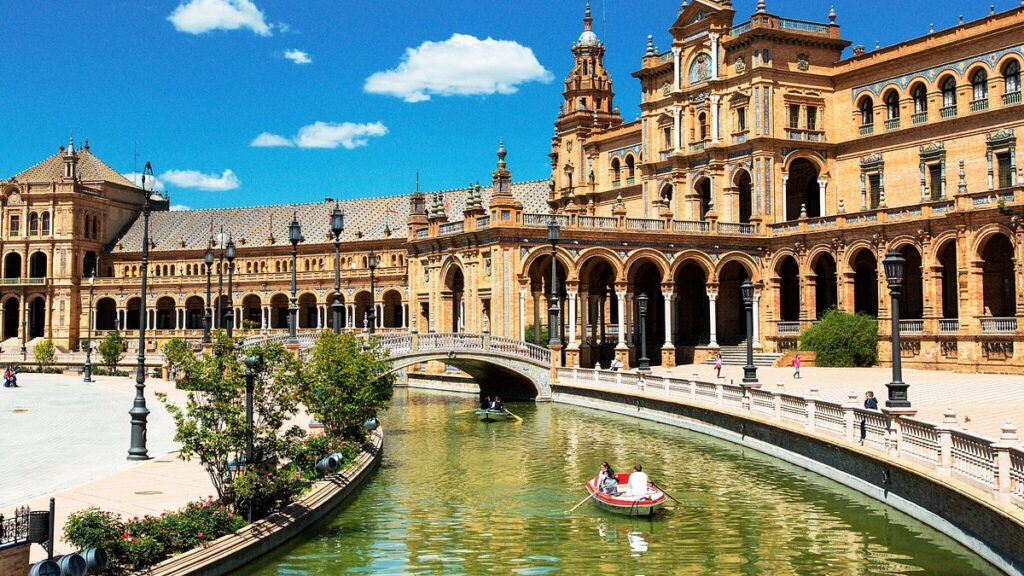Planning a trip to Seville? Whether you’re a history buff, a lover of vibrant cultures, or simply looking to enjoy the Spanish sunshine, Seville offers an array of experiences that will surely captivate your heart. In this blog post, we’ll guide you through the perfect itinerary for spending 3 days in Seville, Spain.
From the grand architecture of the Plaza de España and the rich history of the Seville Cathedral to the passionate rhythms of flamenco, Seville promises a wonderful experience.
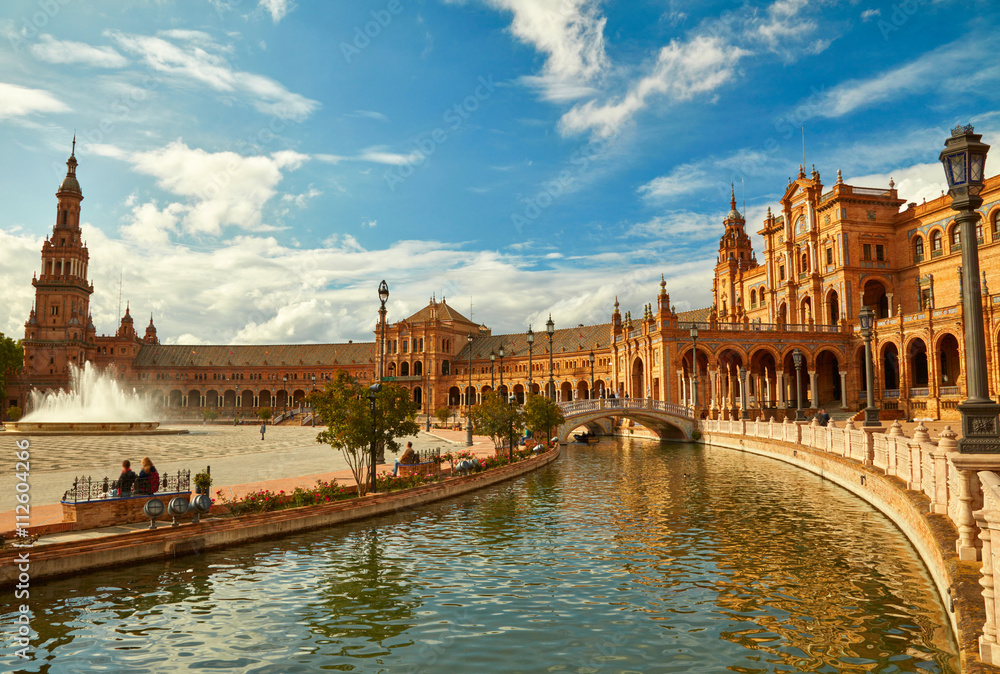
How to Spend 3 days in Seville, Spain
Brief Overview of the History of Seville
Seville, the capital of Andalusia in southern Spain, is a city steeped in rich history and culture. Located on the banks of the Guadalquivir River, Seville is known for its rich blend of Moorish and Christian architectural influences, vibrant flamenco scene, and delicious Andalusian cuisine.
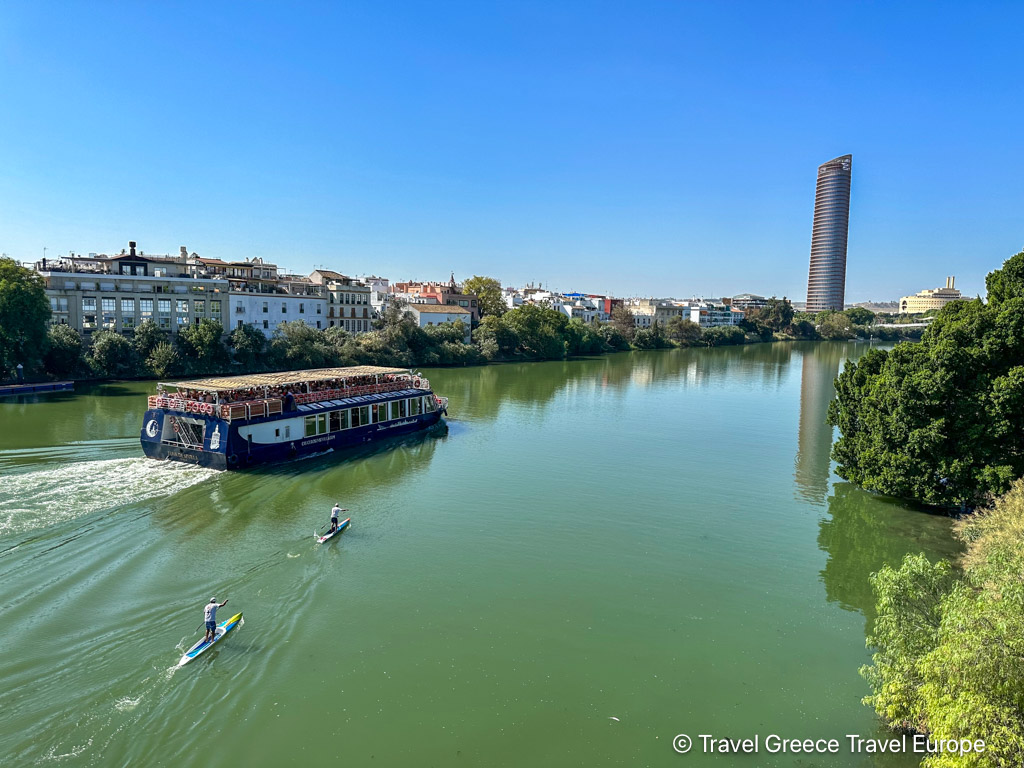
Seville’s history dates back over 2,000 years. It was originally founded as the Roman city of Hispalis before becoming a significant center during the Muslim rule of Al-Andalus. This period left a lasting mark on the city’s architecture, most notably in landmarks such as the Giralda Tower and the Real Alcázar.
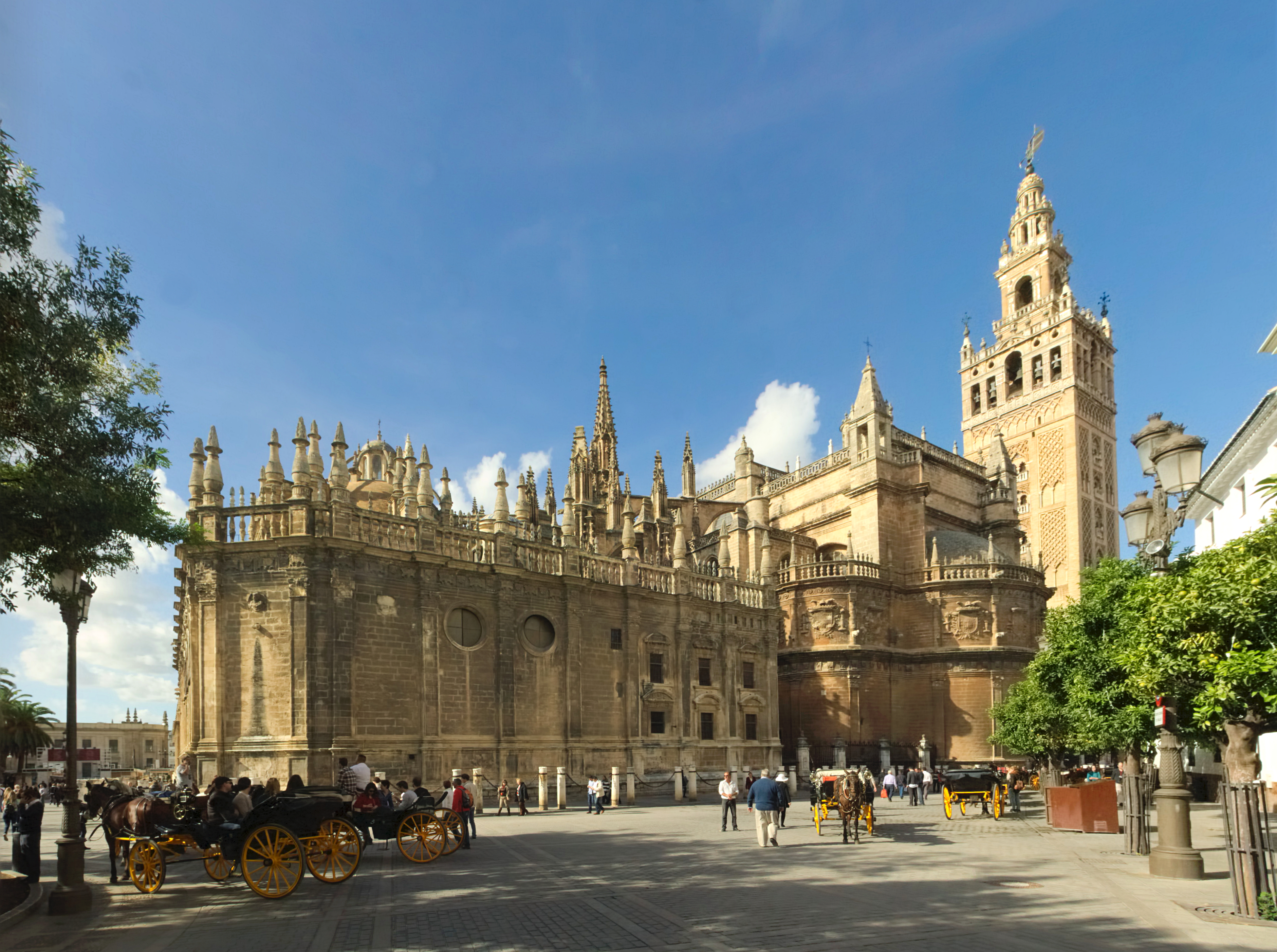
In the 16th century, Seville flourished as a major port during Spain’s Golden Age, serving as a gateway for goods and treasures from the Americas. This era of prosperity endowed the city with grand buildings and a thriving cultural scene.
Today, Seville is a bustling metropolis that celebrates its historical heritage while embracing modernity. Its charming streets, historical monuments, and lively festivals make it a must-visit destination for travelers from around the world.
Getting to Seville
Reaching Seville is convenient and straightforward, thanks to its well-connected transportation network. For international travelers, the San Pablo Airport (SVQ) is the most accessible entry point, offering direct flights from various European cities and connecting flights from major hubs worldwide. From the airport, you can take a taxi or the EA airport bus service to the city center, which is about a 15-minute drive. You can also pre-arrange an airport transfer.
If you prefer traveling by train, the Santa Justa Railway Station in Seville is part of Spain’s high-speed AVE network, providing quick and comfortable connections from cities like Madrid, Barcelona, and Málaga. Additionally, Seville is well-connected by bus services, with major operators offering routes from various parts of Spain and neighboring countries such as Portugal. For those who enjoy road trips, driving to Seville is a scenic option, with well-maintained highways linking it to other Andalusian cities and beyond.
If you are planning to continue your trip and visit Seville from Lisbon you can also book a private transfer. You can also reach Seville from the Algarve (Faro district) in Portugal via a private transfer.
Day 1: Discovering Seville’s Historic Heart
Visit the Seville Cathedral and Giralda Tower
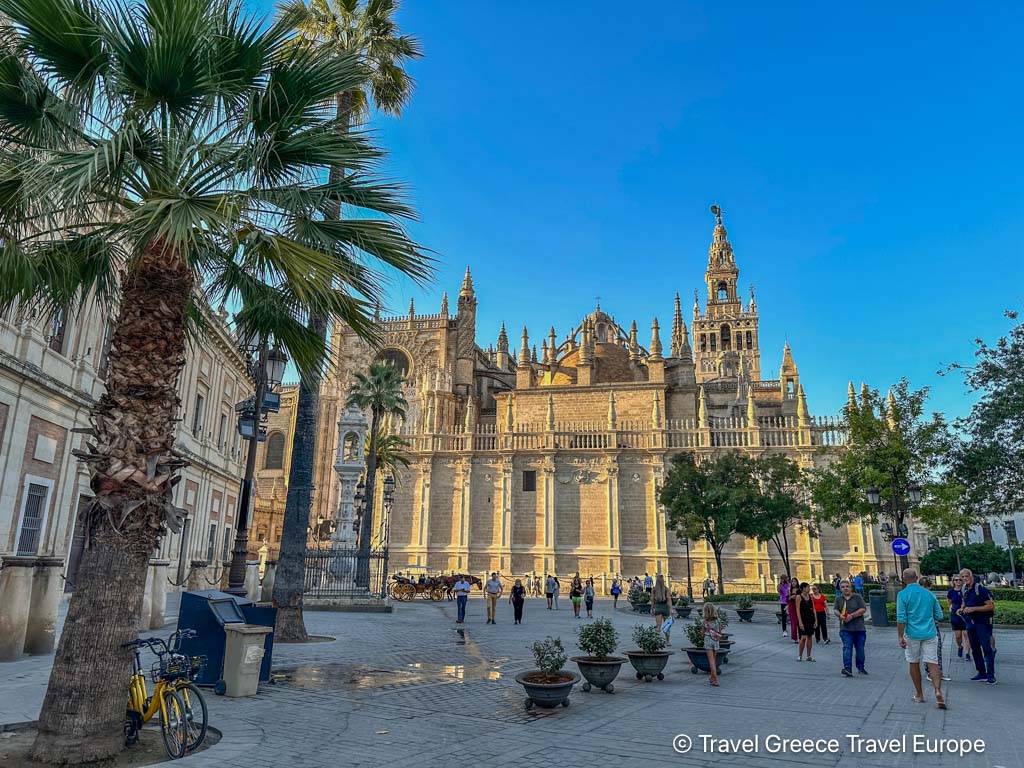
The Seville Cathedral, officially known as the Cathedral of Saint Mary of the See, is a must-visit landmark and an architectural marvel. It holds the title of the largest Gothic cathedral in the world and is also recognized as a UNESCO World Heritage Site. The cathedral was constructed between 1401 and 1506 on the site of a former mosque, reflecting Seville’s rich history of religious and cultural transformation.
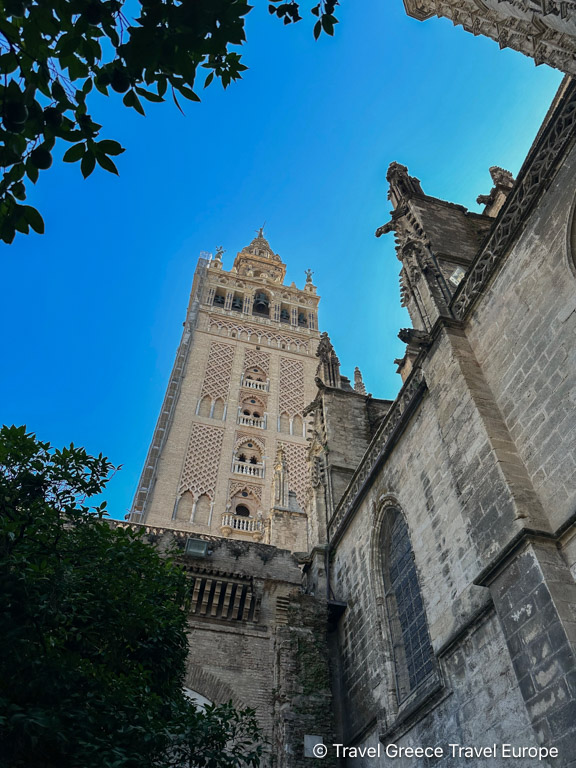
One of the cathedral’s most striking features is the Giralda Tower, originally built as a minaret during the Almohad dynasty in the 12th century. Following the Reconquista, it was converted into a bell tower, preserving its Islamic architectural essence while incorporating Renaissance elements.
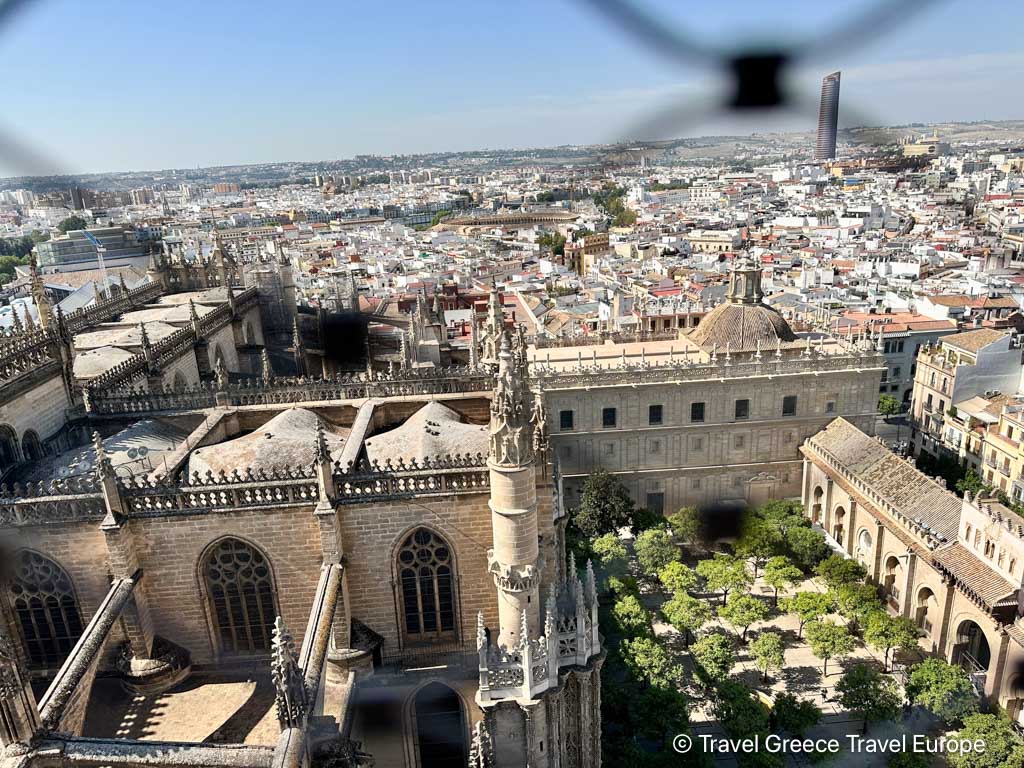
Climbing the Giralda Tower offers breathtaking panoramic views of Seville, a reward for the ascent up its gently sloping ramps.
Inside the cathedral, visitors can marvel at the vast interior, which includes the stunning Capilla Mayor (Main Chapel) with its enormous gilded altarpiece, considered one of the largest in the world.
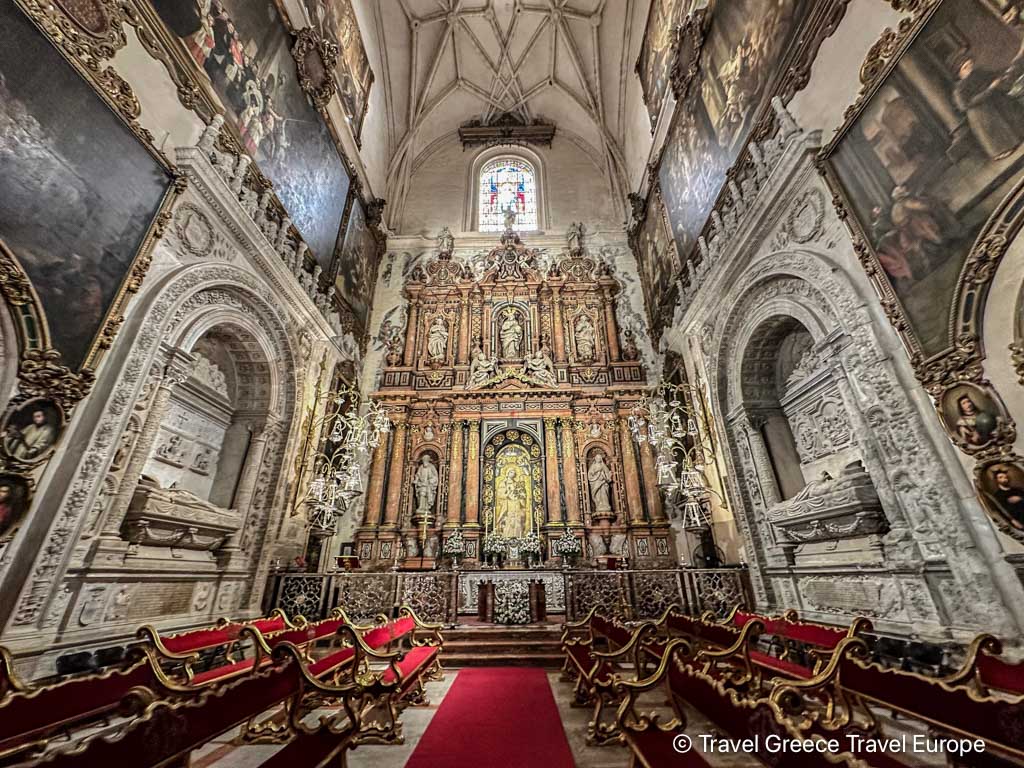
Another significant highlight is the Tomb of Christopher Columbus, which is supported by four statues representing the kingdoms of Castile, León, Aragon, and Navarre. Book your tickets online here.
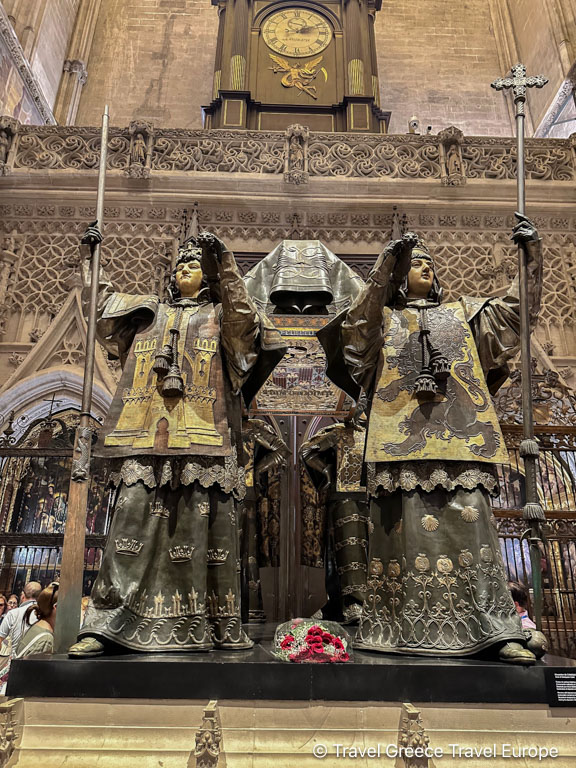
You might also like to opt for the Seville in a Day Tour with VIP Alcazar Access – Certain sights in Seville—the Alcazar, Cathedral, and Jewish Quarter—are on most visitors’ “must-see” lists. On this expertly crafted walking tour of Seville’s highlights, you’ll explore all these and more as an expert guide brings the city’s story to life.
If you enjoy biking, then this City Sightseeing and Local Culture Bike Tour is a great and affordable option. Discover the city’s famous landmarks, relaxed plazas, rich history, and lesser-known spots on this 2 hour tour.
Plaza de España and María Luisa Park
The Plaza de España is one of Seville’s most iconic landmarks, showcasing a stunning blend of Renaissance Revival and Moorish Revival architecture.

Designed by the renowned architect Aníbal González for the 1929 Ibero-American Exposition, the Plaza de España is a semi-circular complex that spans 50,000 square meters. The majestic building is characterized by its grand proportions, intricate tile work, and sweeping arcades.
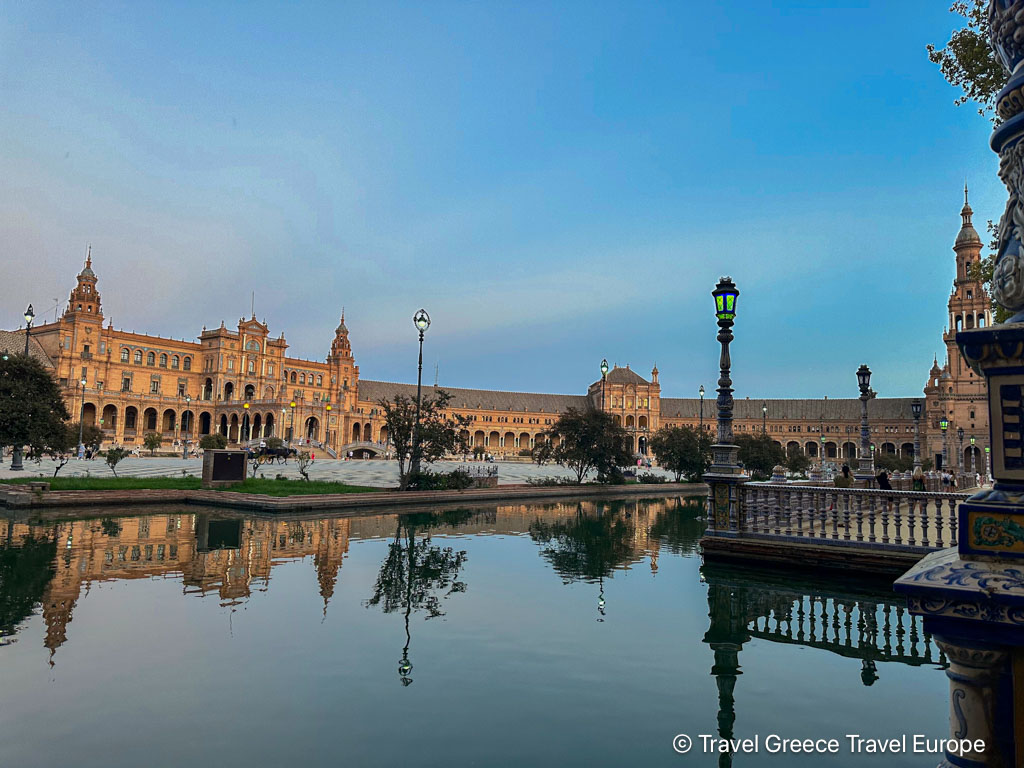
The most captivating feature of the Plaza de España is its elaborate tilework, known as azulejos, which adorns the building and its surroundings. Each of Spain’s provinces is represented by a beautifully painted ceramic tile alcove, detailing historical scenes and local emblems. These alcoves provide a colorful and very informative walk through Spain’s diverse regions.
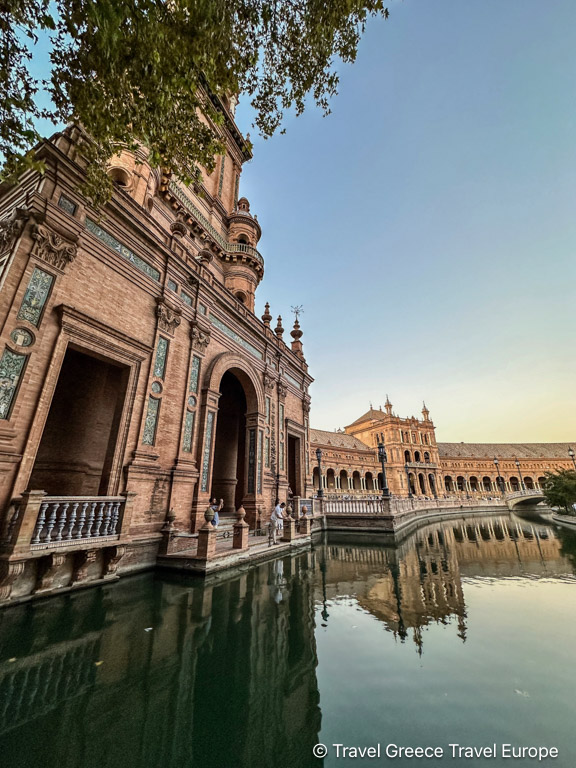
A central canal, crossed by four ornate bridges, adds to the plaza’s picturesque charm, often likened to Venice. Here you can rent rowboats to gently paddle along the canal which offers a unique perspective of this architectural marvel. The grandiose central fountain, Vicente Traver’s Monumento a Alfonso XII, adds to the plaza’s allure, making it a perfect spot for photos and leisurely strolls. I recommend visiting in the late afternoon just before it gets dark, as you can witness its grandeur under the evening lights as well.
María Luisa Park
Adjacent to the Plaza de España is the expansive María Luisa Park (Parque de María Luisa), one of Seville’s most cherished green spaces. Originally part of the private gardens of the San Telmo Palace, the park was donated to the city by Princess María Luisa Fernanda de Borbón in 1893 and redesigned by French landscape architect Jean-Claude Nicolas Forestier in preparation for the 1929 Exposition.
The park spans over 100 acres, offering a serene escape with its lush greenery, meandering pathways, and scenic spots. It features a variety of flora, including towering palm trees, fragrant orange trees, and vibrant flowerbeds, which create a tranquil and refreshing environment.
María Luisa Park is dotted with numerous fountains, ponds, and statues that enhance its beauty. Notable landmarks within the park include the Fountain of the Lions and the Fountain of the Frogs, both of which are popular gathering spots. The park is also home to several museums, such as the Archaeological Museum of Seville and the Museum of Arts and Traditions, housed in beautiful pavilions that add to the park’s historical significance.
Whether you’re exploring the grand architectural splendor of the Plaza de España or enjoying a peaceful retreat in María Luisa Park, this area of Seville offers a perfect blend of cultural richness and natural beauty, making it an essential part of any visit to the city.
Walk Through the University of Seville
The University of Seville is one of Spain’s oldest and most prestigious universities, with a history dating back to 1505. The main building, known as the Royal Tobacco Factory (Real Fábrica de Tabacos), is a remarkable example of 18th-century industrial architecture. This impressive structure, once the largest tobacco factory in Europe, features a blend of Baroque and Neoclassical styles.
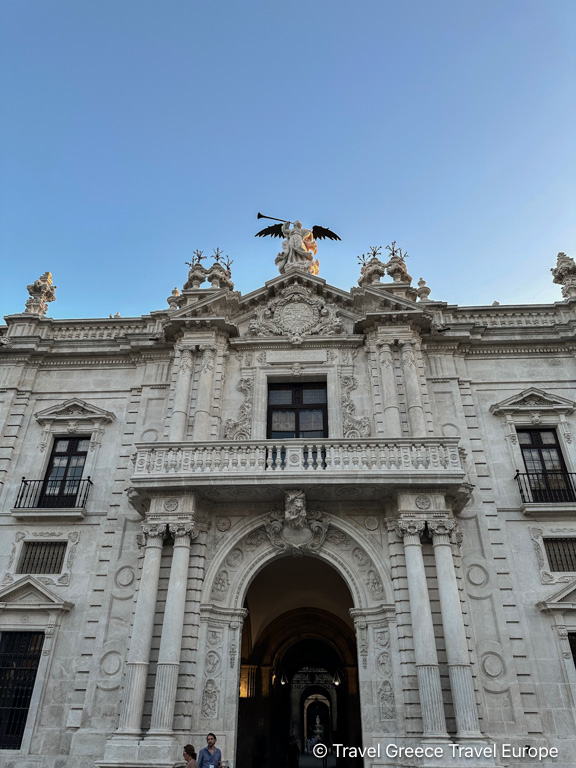
Today, it houses the university’s administrative offices and some academic departments. The building’s grand courtyards, ornate gateways, and historical significance make it a fascinating site for visitors interested in both history and education.
Santa Cruz Quarter
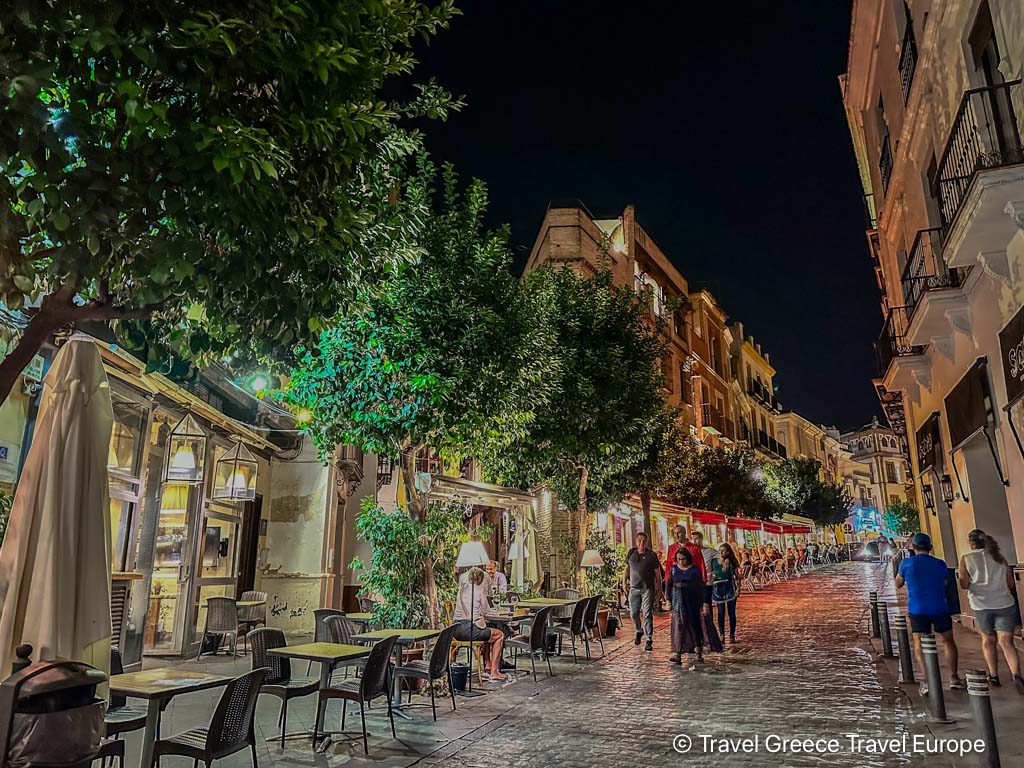
End your day in the charming Santa Cruz Quarter, Seville’s old Jewish neighborhood. Wander through its narrow, winding streets, and discover hidden plazas, whitewashed buildings, and vibrant bougainvillea. For dinner, indulge in traditional tapas at one of the many local eateries. Try dishes like gazpacho, jamón ibérico, and gambas al ajillo.
Day 2: Immersing in Seville’s Cultural Heritage
Morning: Real Alcázar
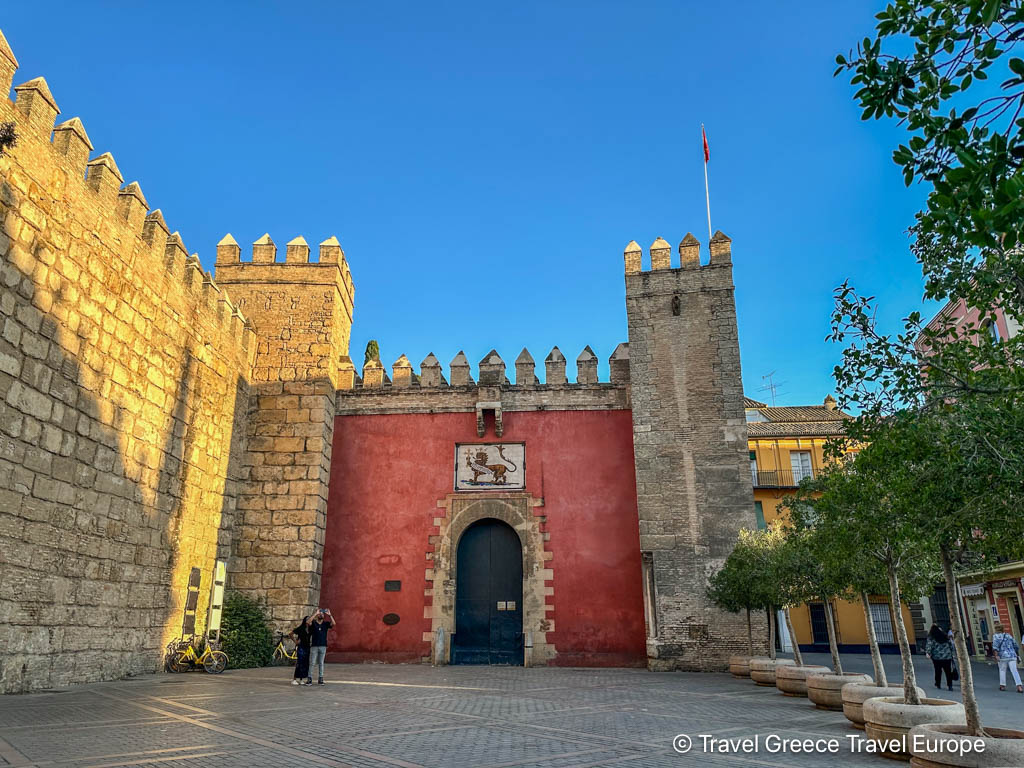
Begin your second day with a visit to the Real Alcázar, a royal palace originally developed by Moorish Muslim kings. This stunning example of Mudéjar architecture boasts intricate tilework, lush gardens, and serene courtyards. It’s also a UNESCO World Heritage Site and a must-visit for history enthusiasts.

The history of the Real Alcázar dates back to the early 8th century when the site was first fortified by the Moors. The palace as we see it today was largely constructed during the reign of Peter of Castile in the 14th century, who employed Muslim craftsmen to create its exquisite Mudéjar architecture. Over time, subsequent monarchs added their own touches, resulting in a unique blend of artistic styles.
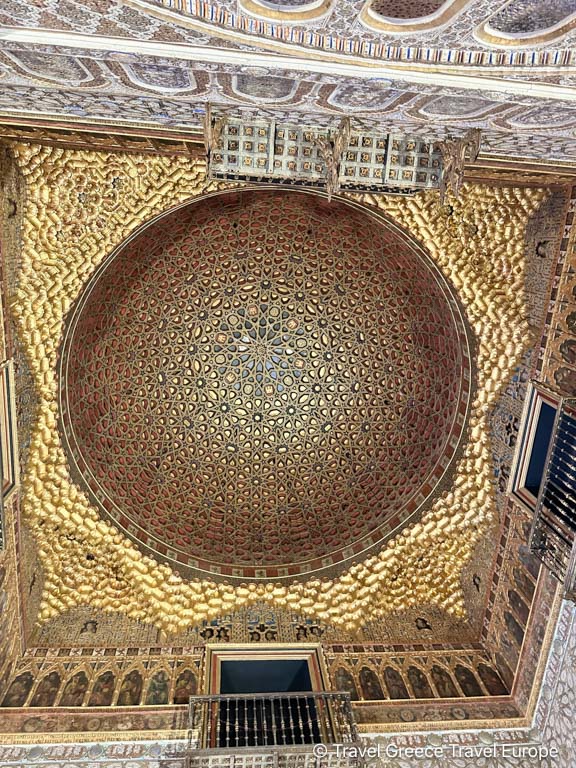
A highlight of the palace is the Salón de Embajadores (Hall of Ambassadors), the main reception room. The hall is adorned with a breathtaking dome covered in elaborate golden carvings and intricate designs, symbolizing the heavens. The room’s walls are lined with beautiful azulejos (ceramic tiles), showcasing the intricate artistry that defines much of the Alcázar.

One of the most striking features of the Real Alcázar is the Patio de las Doncellas (Courtyard of the Maidens). This courtyard is a masterpiece of Mudéjar architecture, with its intricately carved arches, stunning tilework, and reflecting pool. The delicate balance of light and shadow in this space creates a serene and timeless atmosphere.
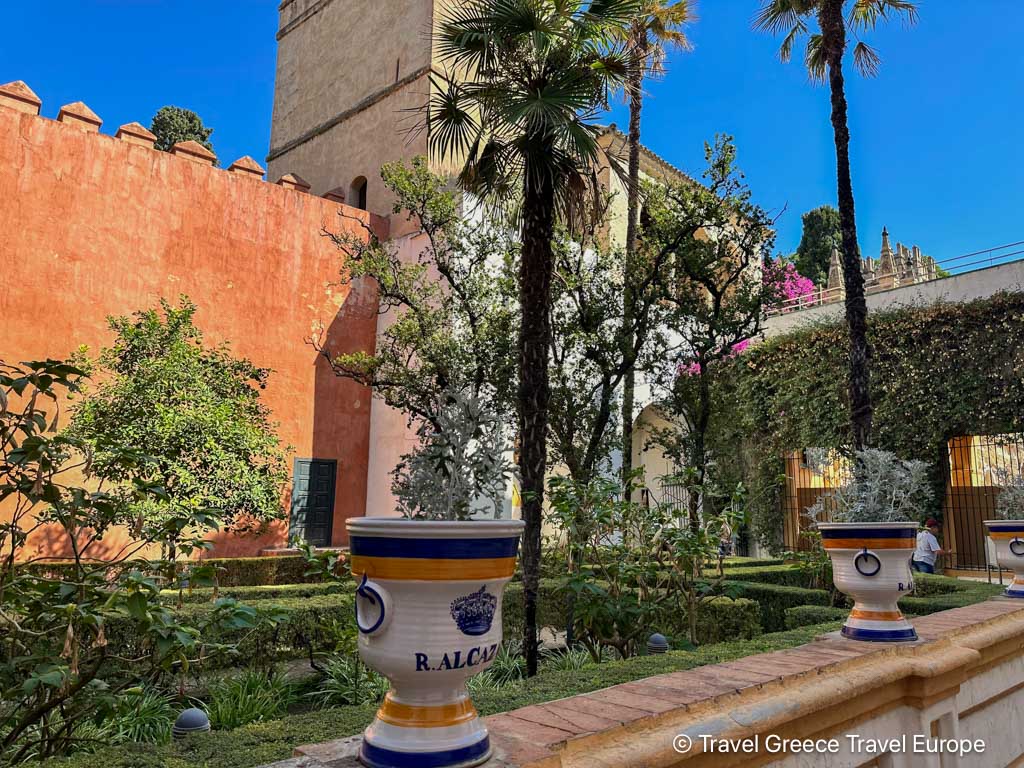
The Gardens of the Real Alcázar are equally enchanting, offering a lush retreat filled with a variety of plants, flowers, and fountains. These gardens are divided into several sections, each with its own unique charm. Highlights include the Mercury Pond, adorned with a bronze statue of Mercury, and the Grotto Gallery, an elevated walkway providing stunning views of the gardens.
Today, the Real Alcázar remains an official residence of the Spanish royal family, making it one of the oldest palaces in Europe still in use. Its historical and cultural significance has made it a popular filming location, most notably featured in the television series Game of Thrones as the palace of Dorne.
Visiting the Real Alcázar
When visiting the Real Alcázar, it’s advisable to book tickets in advance to avoid long queues, especially during peak tourist seasons. Guided tours are available and offer deeper insights into the palace’s history and architecture. Plan to spend at least a few hours exploring the various rooms, courtyards, and gardens to fully appreciate the beauty and history of this remarkable site.
Archivo General de Indias and Flamenco Museum
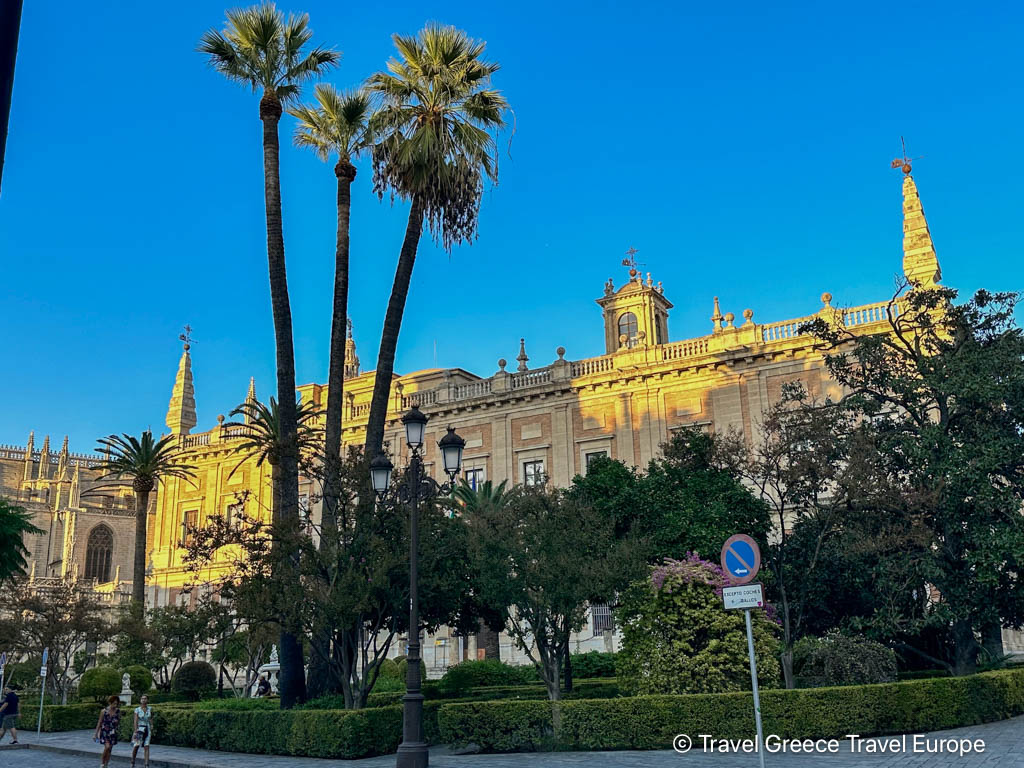
Next, explore the Archivo General de Indias, located near the cathedral. This historic building houses invaluable documents pertaining to the Spanish Empire in the Americas, offering a unique insight into the colonial history.
Enjoy a beautiful lunch at Hotel Alfonso XIII
For a truly memorable dining experience during your visit to Seville, consider having lunch at the prestigious Hotel Alfonso XIII.
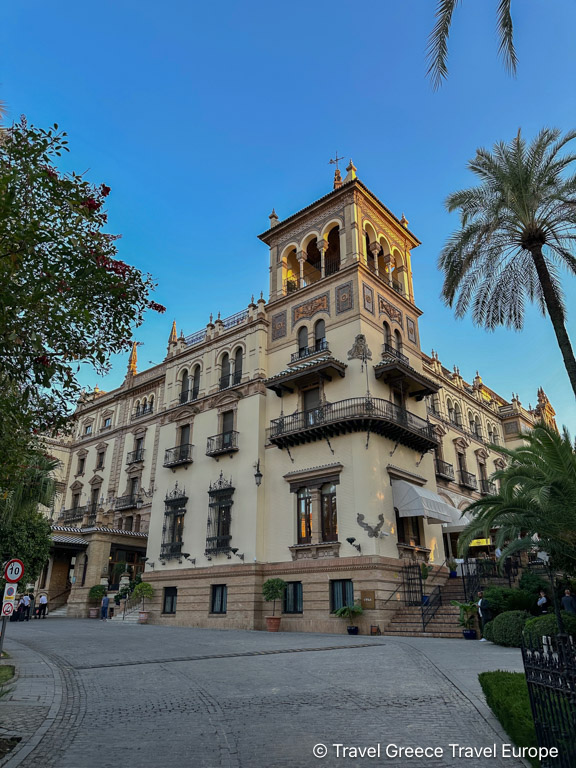
This luxurious hotel, named after King Alfonso XIII and built in 1928, is an architectural gem itself, blending Moorish, Andalusian, and Castilian styles.
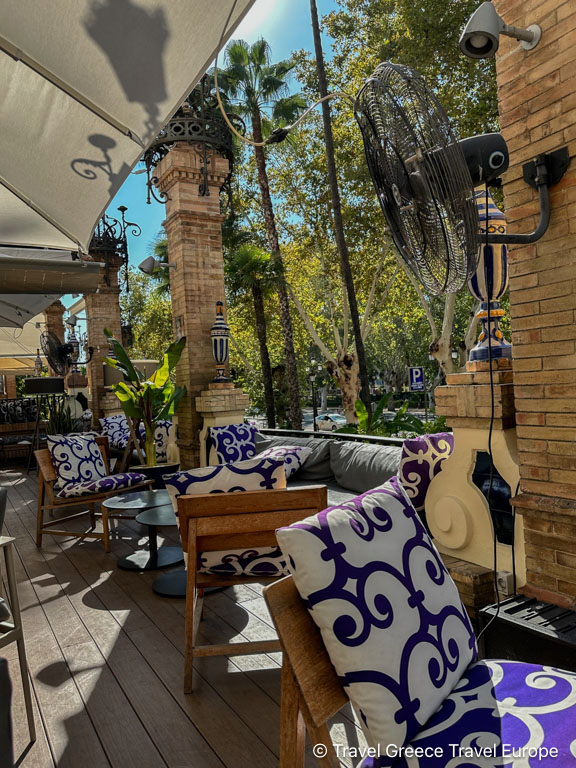
The hotel’s restaurants offer exquisite Andalusian and international cuisine, prepared with the freshest local ingredients. Dining in the elegant surroundings of Hotel Alfonso XIII allows you to immerse yourself in the grandeur of Seville’s historical charm while enjoying a sumptuous meal.

Whether you choose to dine in the serene courtyard of San Fernando Restaurant or the stylish Ena by Carles Abellán with a beautiful outdoor patio, you’re guaranteed a delightful culinary experience that perfectly complements your exploration of this enchanting city.
In the afternoon, you can also delve into the passionate world of flamenco at the Flamenco Museum. Learn about the history and evolution of this traditional Andalusian dance through interactive exhibits, and perhaps catch a live performance.
Evening: Flamenco Show and Tapas
Experience the soul of Seville with a live flamenco show. Many venues across the city offer performances that capture the emotion and intensity of this art form. If you want to experience one of the best flamenco shows I recommend a visit to Tablao Flamenco El Arenal.

Located in the heart of the city and housed in a historical villa, Tablao Flamenco El Arenal was founded by the famous dancer Curro Vélez in 1975 and has since become one of the most respected flamenco venues in Spain. Known for its high-quality performances, the tablao has hosted some of the most talented flamenco artists, including dancers, singers, and guitarists who bring the art form to life with their skill and emotion.
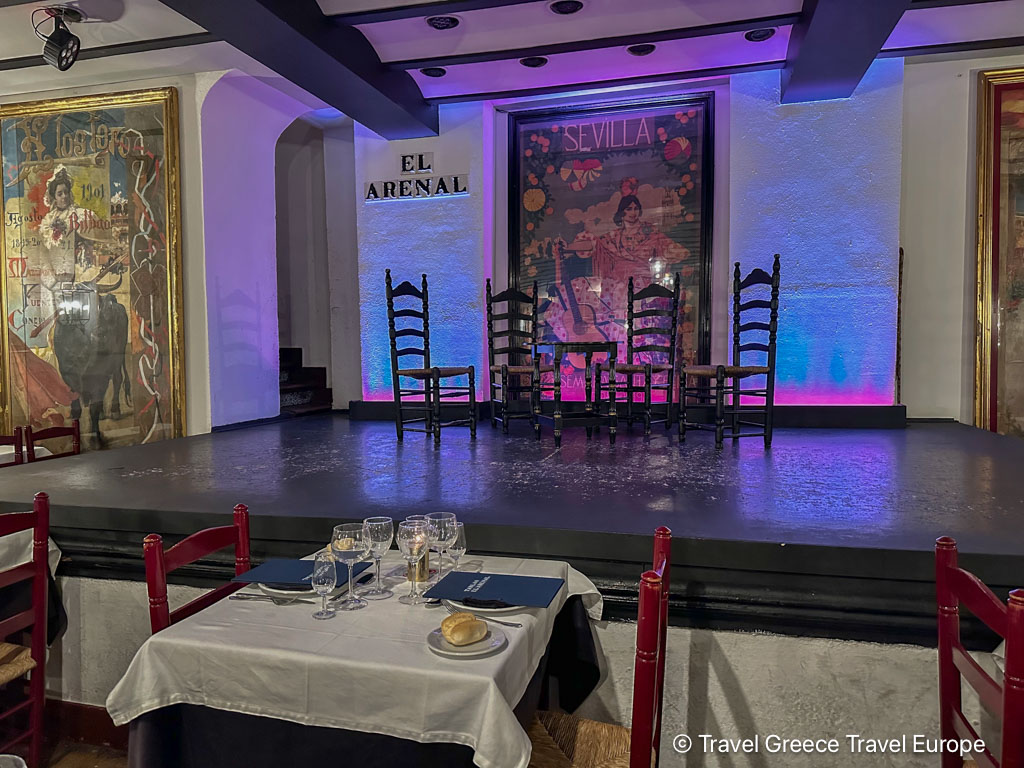
Tablao Flamenco El Arenal also offers a dining option, which allows you to enjoy a delicious meal before the show. The menu features a selection of traditional Spanish dishes, including tapas, Iberian ham, and seafood, accompanied by a selection of fine wines. Dining at the venue adds to the overall experience, making it a perfect evening out in Seville. Alternatively you might like to join this Tapas & Flamenco Suggested Tour: Seville Tapas Crawl with Flamenco Show.
Day 3: Modern Seville and Relaxation
Metropol Parasol
Start your final day 3 in Seville at the Metropol Parasol, also known as Las Setas (The Mushrooms) located in La Encarnación square in the old quarter of Seville. Designed by German architect Jürgen Mayer and completed in 2011, it is renowned for its innovative design and has become a symbol of contemporary Seville.
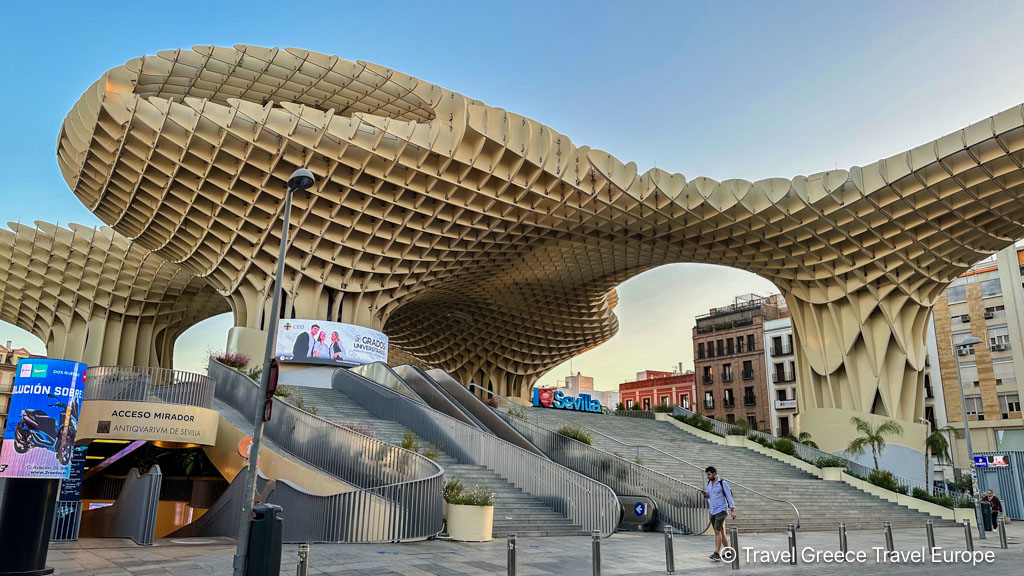
Constructed from wood, Las Setas is one of the largest wooden structures in the world, standing at approximately 26 meters high and covering an area of 150 by 70 meters. The design consists of six large parasols with a honeycomb pattern, creating a visually stunning and futuristic appearance.
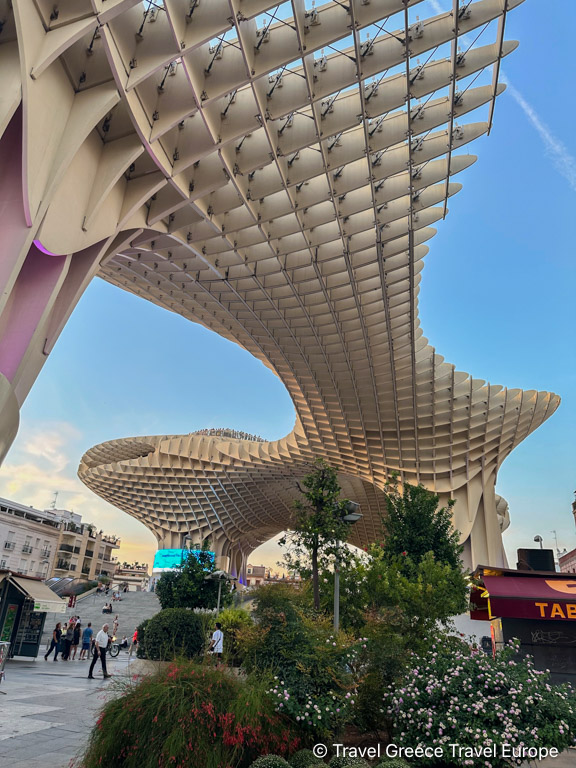
Take the elevator to the top for breathtaking views of the city.
You might also like to join the Las Setas Guided Tour & Optional City Tour – admire Seville’s skyline from Las Setas and learn about the history of the city with a guided tour with 3D content.
Triana and the Guadalquivir River
Cross the Guadalquivir River to explore Triana, a vibrant neighborhood known for its ceramic workshops and lively atmosphere. Visit the Triana Market to sample local produce and enjoy a riverside lunch with views of the city. You might also like to join a 3-hour cooking class at the Triana Market and learn how to cook classic dishes like a local.
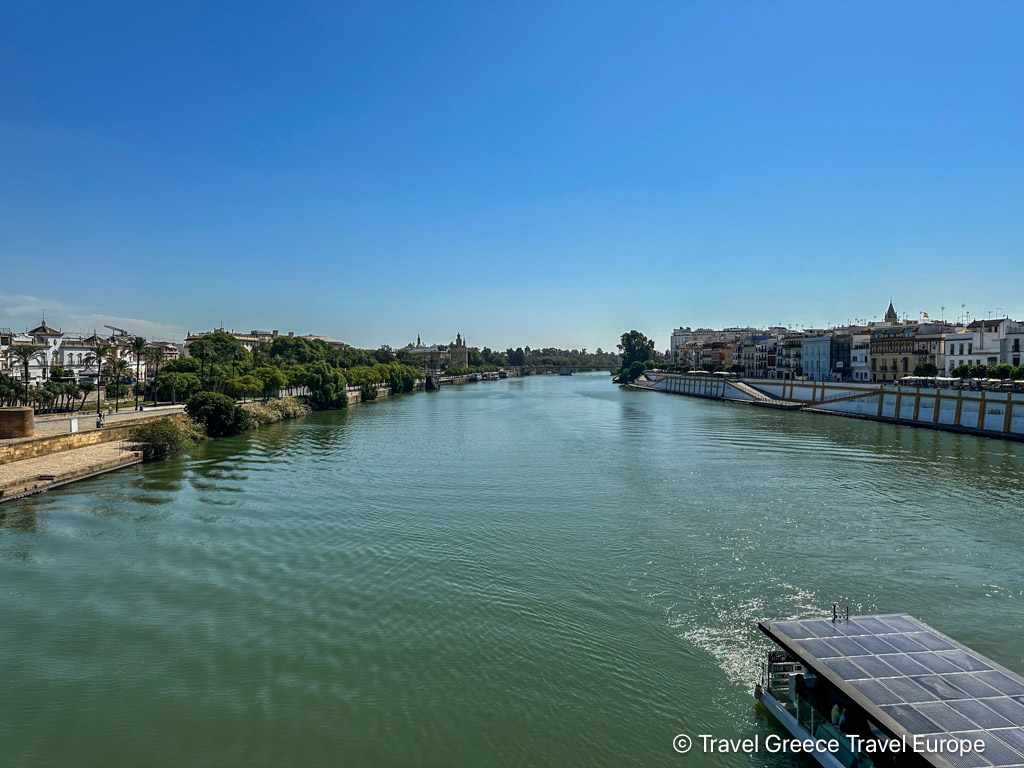
Triana Market sits on the site of the former Castle of San Jorge, a medieval fortress that once served as the headquarters of the Spanish Inquisition. Today, remnants of the castle can still be seen in the market’s underground level, adding a unique historical dimension to the shopping experience.
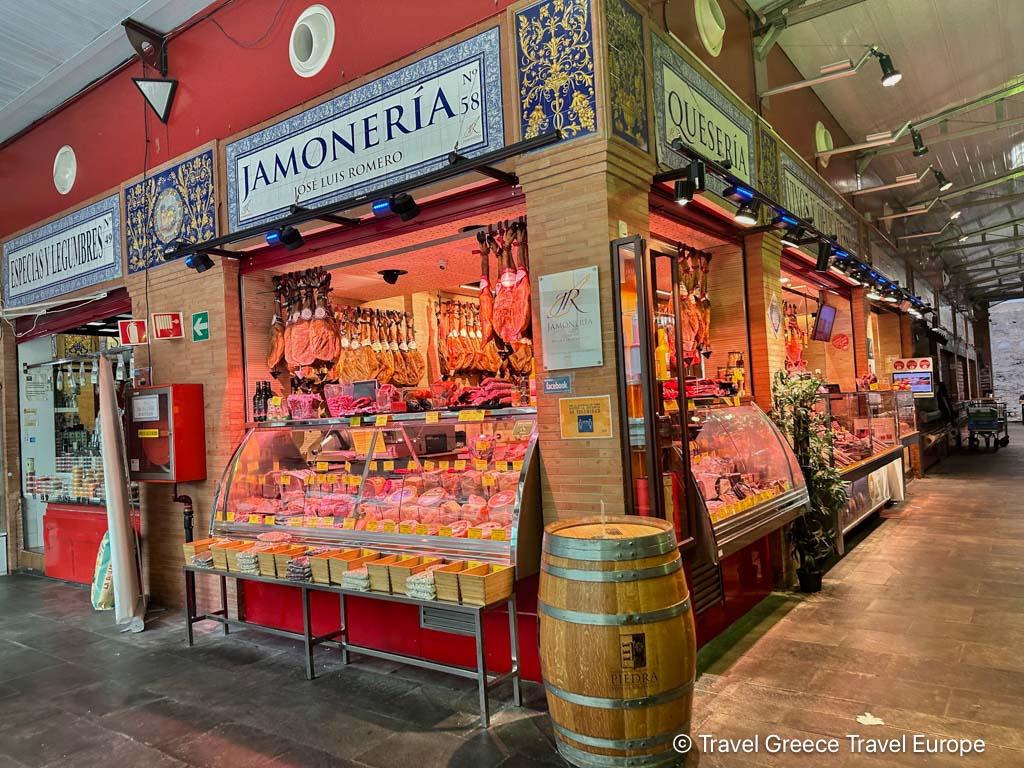
Evening: Relaxing by the River and Dinner
Spend your last evening strolling along the Guadalquivir River (or take a river cruise). Enjoy the picturesque sunset, reflecting on your incredible journey through Seville. For dinner, choose a riverside restaurant and savor Andalusian cuisine one last time. You might also enjoy taking a Triana Neighborhood Tapas tour.
Where to Stay in Seville: Accommodation Options for Every Traveler
Seville offers a wide range of accommodation options to suit every traveler’s needs and budget. From luxurious hotels and charming boutique inns to budget-friendly hostels and vacation rentals, the city provides numerous places to stay, each offering its own unique experience. Here are some of the best areas and recommended accommodations in Seville:
Casco Antiguo: The Heart of Seville
Casco Antiguo, Seville’s Old Town, is a prime area to stay in for those wanting to be close to the city’s main attractions, such as the Seville Cathedral, the Giralda Tower, and the Real Alcázar. This area is filled with narrow, winding streets, historical buildings, and a vibrant atmosphere.
Santa Cruz: Historical Charm
Santa Cruz is the heart of Seville’s old town and one of the most picturesque neighborhoods in the city. Staying here puts you within walking distance of major attractions like the Seville Cathedral, the Giralda Tower, and the Real Alcázar.

El Arenal: Riverside Elegance
El Arenal is another excellent choice, especially for those interested in staying close to the Guadalquivir River and Seville’s bullring, the Plaza de Toros de la Maestranza.
Triana: Authentic Seville
For a more local experience, consider staying in Triana, a neighborhood known for its flamenco culture, ceramic workshops, and lively atmosphere.
Day Trips to Take from Seville
Seville is not only a captivating city in itself but also an excellent base for exploring the surrounding region of Andalusia and beyond. Here are some fantastic day trips you can take from Seville:
Córdoba
A full Day Trip from Seville, Córdoba is a city rich in history and culture. The highlight is the stunning Mezquita-Catedral, a former mosque turned cathedral that showcases a unique blend of Islamic and Christian architecture. Wander through the charming streets of the Jewish Quarter, visit the Alcázar of the Christian Monarchs, and relax in the beautiful Patios de Córdoba, especially during the spring festival. Book your spot online here. Duration 10 hours.

Ronda
Known for its dramatic cliffs and breathtaking views, Ronda is a picturesque town that offers a perfect escape from the city. The town is famous for the Puente Nuevo, a stone bridge that spans the deep El Tajo Gorge, offering spectacular vistas. Visit the historic Plaza de Toros, one of Spain’s oldest bullrings, and explore the Arab Baths and the Palacio de Mondragón for a glimpse into Ronda’s rich past. Check out this White Villages and Ronda Day Tour from Seville. Duration 10 hours.
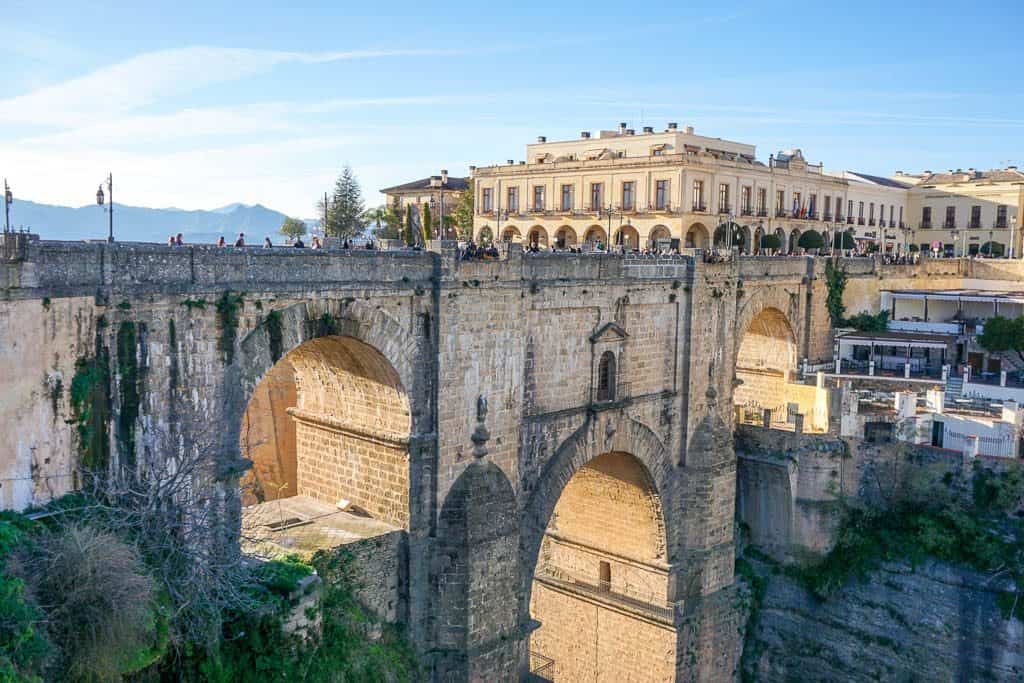
Granada
A visit to Granada is a must for its iconic Alhambra Palace, a breathtaking fortress and palace complex that is one of Spain’s most famous landmarks. The Alhambra’s intricate Islamic art and architecture, lush gardens, and panoramic views of the Sierra Nevada mountains are truly unforgettable. Explore the charming Albaicín neighborhood with its narrow, winding streets and traditional whitewashed houses. Don’t miss the opportunity to experience a traditional tetería (tea house) and savor the local cuisine, including delicious tapas and pastries. Check out this full day trip here. Duration 13 hours.
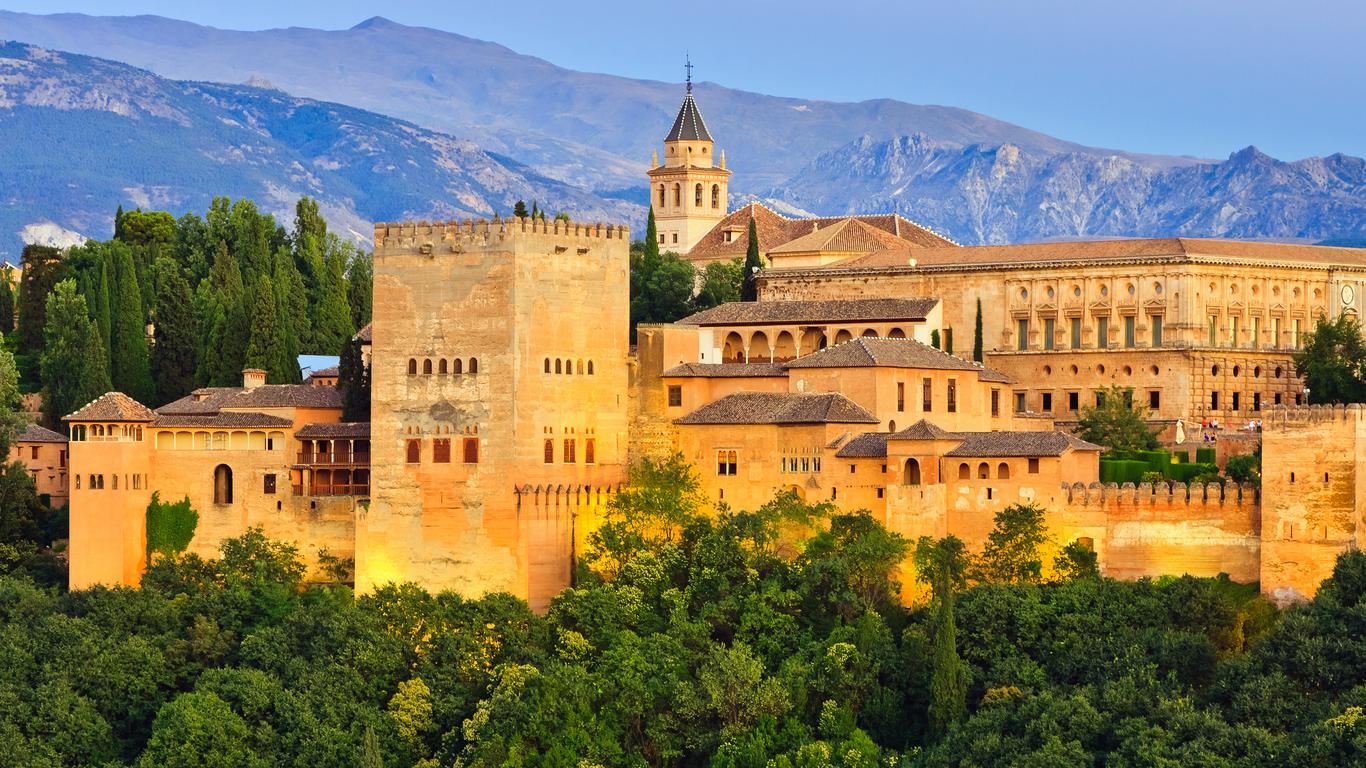
Jerez de la Frontera
For those interested in Spanish culture, a trip to Jerez de la Frontera is a must. Known for its sherry production, you can tour some of the region’s most famous bodegas (wineries) and sample exquisite sherry wines. Jerez is also the birthplace of flamenco, and you can catch a traditional flamenco show or visit the Royal Andalusian School of Equestrian Art to see the renowned Andalusian horses in action. Check out this Cadiz and Jerez de la Frontera Day Trip. Duration 10 hours.
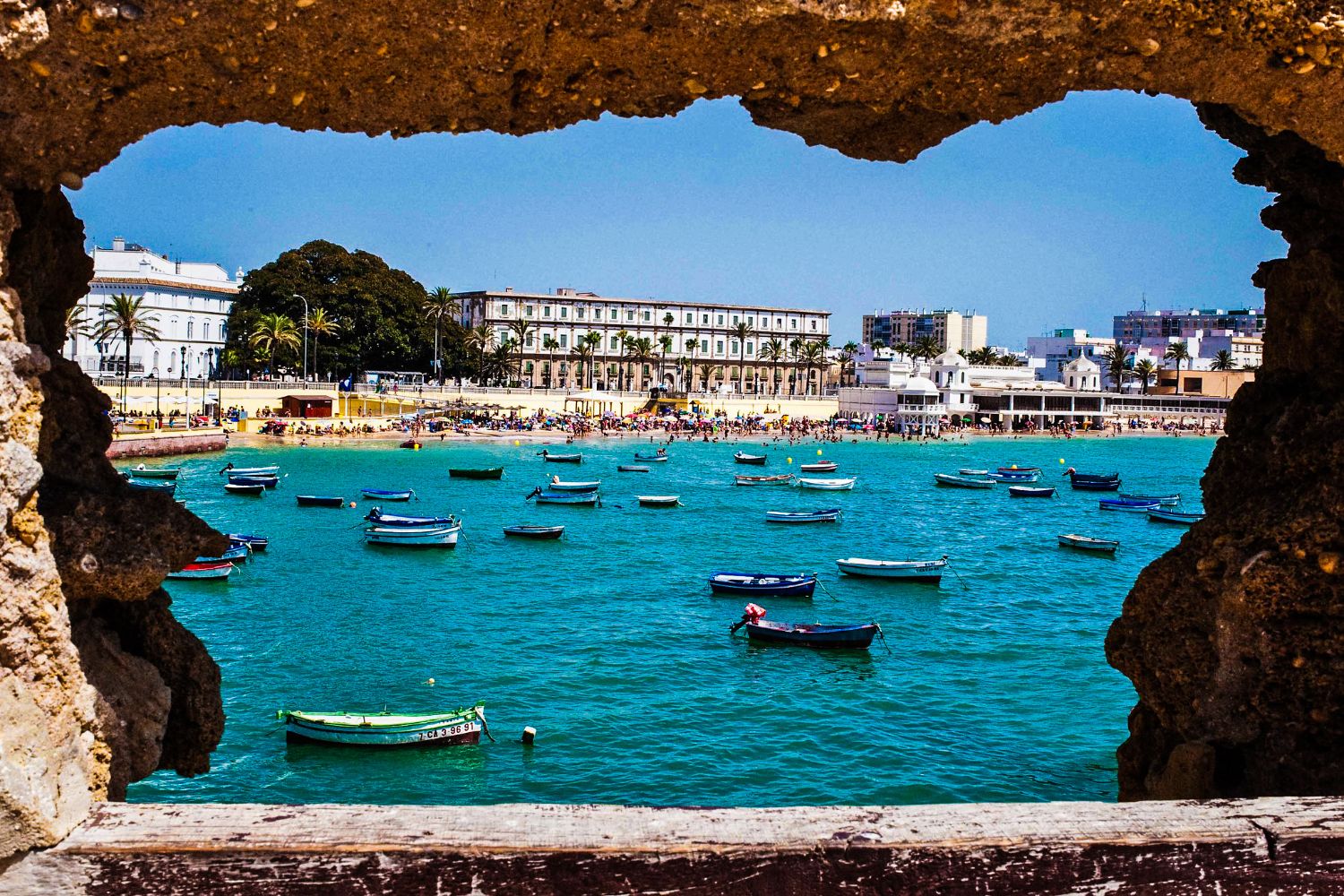
Doñana National Park
Nature lovers will enjoy a visit to Doñana National Park, one of Europe’s most important wetland reserves. This UNESCO World Heritage Site is home to a diverse range of flora and fauna, including endangered species like the Iberian lynx and Spanish imperial eagle. Explore the park’s varied landscapes, from marshes and dunes to forests and lagoons, either on a guided tour or by joining a safari.

Caminito del Rey
For adventure enthusiasts, a day trip to the Caminito del Rey from Seville offers an exhilarating experience. Known as one of Spain’s most thrilling hiking paths, the Caminito del Rey is a walkway pinned along the steep walls of a narrow gorge in El Chorro, near Málaga. Your journey begins with a scenic drive from Seville to the starting point of the trail. The trek itself spans approximately 7.7 kilometers and takes you through stunning landscapes, including towering cliffs, canyons, and a suspension bridge that hangs 100 meters above the river below. As you walk along the narrow, vertigo-inducing paths, you’ll be treated to breathtaking views of the surrounding natural beauty. The Caminito del Rey, once dubbed the “world’s most dangerous walkway,” has been meticulously restored and is now safe for hikers, providing an adrenaline-pumping adventure amidst some of Andalusia’s most spectacular scenery. After completing the trek, you’ll return to Seville with unforgettable memories of this unique and thrilling day out.

Gibraltar
For a unique blend of British and Mediterranean culture, consider a day trip to Gibraltar. This British Overseas Territory is famous for the Rock of Gibraltar, which offers stunning views of the Mediterranean Sea and the Atlantic Ocean. Take a cable car ride to the top of the rock, visit the Great Siege Tunnels, and explore the St. Michael’s Cave. Don’t miss meeting the famous Barbary macaques, the only wild monkey population in Europe. The town itself is also worth exploring, with its quaint British-style pubs, shops, and the historic Moorish Castle. Book this organized day trip here. Duration 11 hours.

Conclusion
Seville is a city that captivates the hearts of all who visit with its rich history, stunning architecture, vibrant culture, and delectable cuisine. Over the course of 3 days in Seville, Spain, you will have experienced the best this enchanting city has to offer, from the majestic Seville Cathedral and the historical Real Alcázar to the lively atmosphere of Triana Market and the modern marvel of Las Setas. Whether you’re strolling through the lush gardens of María Luisa Park, savoring tapas at a local bar, or immersing yourself in a passionate flamenco performance, Seville promises an unforgettable journey filled with magical moments.


